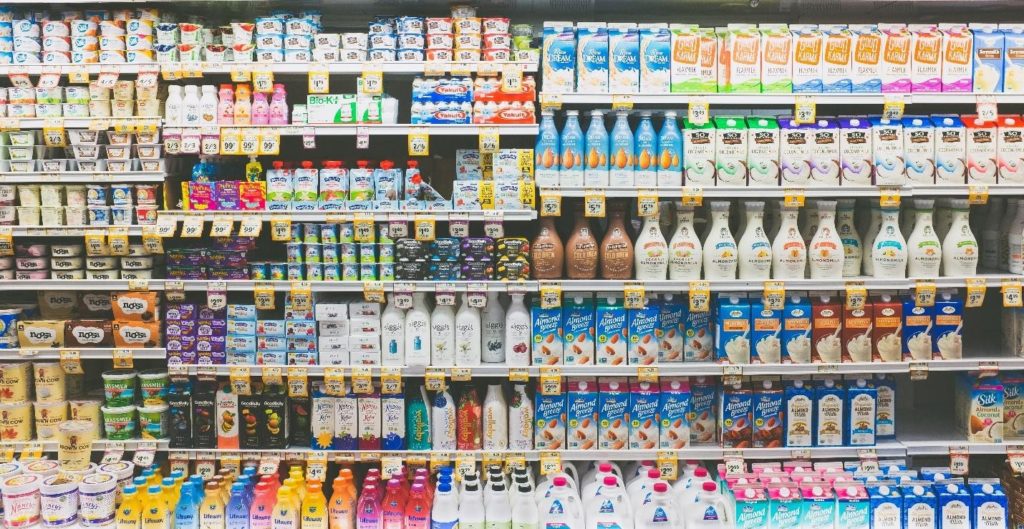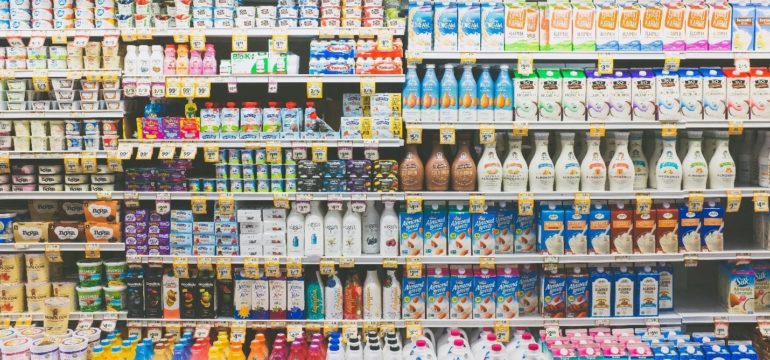BY: LAUREN SIPPLE

Almond-based beverages lead the non-dairy milk category with a 64% market share (Photo by rawpixel.com from Pexels)
Fluid milk consumption in the United States has declined steadily since the 1970s. A study by the USDA’s Economic Research Service found the decline appears to be related to generational differences, with younger generations consuming milk less often than preceding generations and therefore decreasing per capita consumption (Stewart et al., ).
Meanwhile, non-dairy milk alternative sales have grown by over 60% in the last five years, and the dairy alternatives market is projected to grow to $19.5 billion by 2020 (Mintel, 2018; Plant Based Foods Association, 2016). A survey by The International Food Information Council Foundation found that 38% of American adults purchase non-dairy milk alternatives, with adults under the age of 45 purchasing more of these alternatives than older adults (Food Insights, 2018).
Plant-based dairy substitutes are made from legumes, oil seeds, cereals, or pseudocereals, and resemble products made with cow’s milk (Makinen et al., 2015). Plant-based milk alternatives originated from a variety of plant-based beverages from Asia, the Middle East, and India. Today, a variety of non-dairy alternatives can be found on grocery store shelves. Table 1 below contains some examples of traditional dairy products and the plant bases that constitute their non-dairy alternatives.
While plant-based dairy product alternatives do not actually contain dairy, many of them still use dairy product terminology to describe themselves to consumers. This article will discuss efforts by the dairy industry to petition the FDA to ban the use of dairy product terminology on plant-based alternatives, the FDA’s latest response as it relates to current regulations and health concerns, and finally the stance of the plant-based alternatives industry regarding these issues.
Table 1. Dairy Products and the Plant Bases for their Non-Dairy Counterparts
| Dairy Product | Plant-Based Alternative Bases |
| Milk | Soy, almond, rice, coconut, cashew, peanut, hemp, oat, pea, macadamia, hazelnut, flax |
| Yogurt | Almond, coconut, cashew, soy, flax, hemp |
| Cheese | Cashews, macadamia, almond (for soft cheeses)
Soy, pea starch/protein + vegetable oils (for hard cheeses) |
| Ice Cream | Coconut, cashew, almond, soy, avocado |
The Labeling Debate: A Brief History
The proliferation of plant-based dairy alternatives is certainly a concern for the dairy industry. For at least 20 years, the dairy industry has been lobbying for enforcement of standards of identity for dairy products, claiming that plant-based milk, yogurt, cheese, and other alternative products should not be allowed to utilize the names of their dairy counterparts. The most recent – and perhaps most successful – push in this effort is a result of the DAIRY PRIDE Act.
The DAIRY PRIDE Act
The Defending Against Imitations and Replacements of Yogurt, milk, and cheese to Promote Regular Intake of Dairy Everyday Act, also known as the DAIRY PRIDE Act, was introduced to Congress by Wisconsin Senator Tammy Baldwin in January 2017. This bill was introduced due to concerns that consumers are misled by plant-based products that use dairy product names in the sense that it conveys nutritional equivalency, which is often not the case (DAIRY PRIDE Act, 2017).
Consumption of dairy products has been associated with prevention of numerous diseases including hypertension, cardiovascular disease, obesity, osteoporosis, and cancer (especially colon cancer) (Ebringer et al., 2008). However, the 2015-2020 Dietary Guidelines for Americans found that most Americans are not meeting the recommended intake for dairy foods. The guidelines recommend a shift to eating more low-fat and fat-free dairy products in nutrient-dense forms (such as milk, yogurt, and cheese) to increase intake of calcium, vitamin D, and potassium (U.S. Department of Health and Human Services and U.S. Department of Agriculture, 2015). Fortified soy beverage is the only milk alternative that is considered part of the Dairy group in the Dietary Guidelines as it does have a similar nutrient composition to dairy milk (FDA, 2018).
The purpose of the DAIRY PRIDE Act is to prevent misbranded foods from entering commerce; that is, products that use a dairy product name, but do not meet the criterion of dairy products as established by the Food, Drug, and Cosmetic Act. The bill would amend section 403 of the Food, Drug, and Cosmetic Act to ensure improved enforcement of dairy product standards of identity (DAIRY PRIDE Act, 2017).
Support of the Dairy Industry
The National Milk Producers Federation (NMPF), an organization that develops and carries out policies to advance the well-being of dairy farmers, supports the passage of the DAIRY PRIDE Act. The organization believes that dairy imitation products benefit by associating themselves with dairy and advertising themselves as suitable replacements for dairy products, even though they are nutritionally inferior (National Milk Producers Federation, 2017).
Jim Mulhern, the President and CEO of the NMPF, told FDA regulators that regulatory agencies in Canada, the UK, and the European Union actively prevent improper labeling of imitation dairy products. “These countries prove that by actively enforcing standards of identity, dairy-free alternatives and real milk can co-exist without conflict,” said Mulhern. “We are not trying to eliminate the marketing of these foods. We want to end the consumer deception associated with these products and for FDA to enforce its regulations on product integrity. We will continue to push on this issue until FDA acts to ensure dairy standards are enforced.”

The current Standard of Identity for milk is defined as a lacteal secretion. (Image by rawpixel.com)
The FDA Commissioner Makes a Statement
In late September 2018, FDA Commissioner Scott Gottlieb announced that the FDA would be modernizing standards of identity as part of their multi-year Nutrition Innovation strategy. In his statement, the commissioner acknowledges concerns related to labeling plant-based dairy alternatives and their perceived nutritional content. While the FDA does not want consumers to be misled, they still support marketplace innovation, such as the innovations that have taken place in the dairy-alternative category.
To begin tackling this issue, the FDA issued a request for information in the Federal Register in an attempt to gain insights into how consumers use plant-based alternatives, as well as their understanding of labels such as “milk,” “yogurt”, or “cheese”, and the inherent differences (nutritional and otherwise) of dairy and plant-based alternative products (FDA, 2018). The comment period has been extended and will end on January 28, 2019.
The author encourages you to share your comments with the FDA regarding your perceptions on the use of dairy names in labeling of plant based products by accessing this webpage: https://www.federalregister.gov/documents/2018/09/28/2018-21200/use-of-the-names-of-dairy-foods-in-the-labeling-of-plant-based-products
Current Labeling Regulations
According to 21 CFR 131.110, the FDA defines milk as “the lacteal secretion, practically free from colostrum, obtained by the complete milking of one or more healthy cows.” Yogurt, cheese, cream, and ice cream are other products which each have a Standard of Identity specifying that foods with these labels must contain dairy ingredients.
21 CFR 101.3 discusses identity labeling for food, and specifies that “a food shall be deemed to be misbranded if it is an imitation of another food unless its label bears, in type of uniform size and prominence, the word “imitation” and, immediately thereafter, the name of the food imitated.” Foods that resemble another food but are nutritionally inferior are deemed to be imitation foods. If the food is not nutritionally inferior, then it should bear a common name or descriptive term that is not false or misleading.
This begs the questions:
- Are plant-based dairy alternatives nutritionally comparable to milk and other dairy products?
- Is using dairy terms to describe these alternatives misleading to consumers?
To answer the latter of these two questions, a survey by the International Food Information Council (IFIC) Foundation in October 2018 investigated consumer attitudes about the labeling of dairy and non-dairy alternative products. The survey of 1,000 adults found that the majority of Americans understand which products contain milk from cows and which do not when shopping for products that carry the label “milk”. Less than 10% of respondents believed that coconut, soy, cashew, and rice “milk” contain cow’s milk (Food Insight, 2018). On the other hand, at least 3 out of 4 Americans understand that whole milk, chocolate milk, non-fat milk, and skim milk contain cow’s milk.
The product name that created the greatest confusion for consumers was “lactose-free milk”, with 48% of consumers believing it contains cow’s milk, 31% believing it does not, and 22% saying that they didn’t know (Food Insight, 2018).

Today’s consumers face a myriad of choices in the dairy case with new innovations in dairy and non-dairy products (Photo by NeONBRAND on Unsplash).
Concerns of the FDA and the Dairy Industry
Consumer Perceptions
If the majority of consumers are not confused which products contain dairy milk and which ones do not, what is the concern? According to a study by the National Dairy Council (NDC), a non-profit committed to science-based education about the nutrition and health benefits that dairy foods provide, the main reason consumers believe plant-based milks are labeled as “milk” is because the products are nutritionally comparable (NDC, 2018). In his statement, the FDA commissioner expressed concerns that some plant-based dairy alternatives are not nutritionally equivalent to dairy products and the under-consumption of key nutrients due to substitution with plant-based alternatives compromises the health and well-being of the US population (FDA, 2018).
A study by the NDC investigated the perceptions of dairy milk and plant-based alternatives in regards to their nutritional content. The study of 2,010 US adults found that the majority of consumers perceive almond, soy, and coconut milks to have the same or more protein and key nutrients as dairy milk. This perception is perhaps related to the findings of a study by Mintel research, which found that 1 in 5 Americans say they are consuming less dairy for health reasons (Mintel, 2018).
Nutritional Content of Dairy versus Plant-Based Alternatives
The reality is that the nutritional content of plant-based dairy alternatives can vary greatly (Table 2). Whereas the FDA standardizes the nutritional content of many cow’s milk products, non-dairy, plant-based counterparts are not subject to the same standards (Morency et al., 2017). The raw material, processing, fortification, and presence of other ingredients can all play a role in nutritional differences in plant-based alternatives.
Table 2. Comparison of key nutrients in dairy and non-dairy milk products*
| Product | Calories per cup | Protein (g/cup) | Fat (g/cup) | Sugars (g/cup) | Calcium (% DV) | Potassium (% DV) | Vitamin A (% DV) | Vitamin D (IU/cup) |
| Whole Milk | 150 | 8 g | 8 g | 11 g | 30% | 10% | 6% | 25% |
| Skim Milk | 80 | 8 g | 0 g | 11 g | 30% | 10% | 10% | 25% |
| Lactaid Fat Free Milk (Lactose removed with lactase) | 90 | 8 g | 0 g | 12 g | 30% | 12% | 10% | 25% |
| Fairlife Skim Ultrafiltered Milk (Lactose removed via ultrafiltration) | 80 | 13 g | 0 g | 6 g | 40% | Not Available | 10% | 25% |
| Almond Breeze Original Almondmilk | 60 | 1 g | 2.5 g | 7 g | 10% | 5% | 10% | 25% |
| Silk Original Soymilk | 110 | 8 g | 4.5 g | 6 g | 30% | 8% | 15% | 15% |
| SO Delicious Coconutmilk | 70 | <1 g | 4.5 g | 7 g | 10% | 1% | 10% | 30% |
| Ripple Original Pea Milk | 100 | 8 g | 4.5 g | 6 g | 45% | 13% | 10% | 30% |
| Califia Farms Cashew Homestyle Nutmilk | 120 | 2 g | 10 g | 1 g | 2% | 2% | 0% | 0% |
| The Original Oatly Oatmilk | 120 | 3 g | 5 g | 7 g | 25% | 8% | 20% | 20% |
*Values obtained from USDA Food Composition Databases and product websites.
The National Dairy Council cites nine essential nutrients that milk provides: high-quality protein, calcium, Vitamin D, phosphorus, Vitamin A, Vitamin B12, riboflavin, pantothenic acid, and niacin. Whereas commercially available cow’s milk is typically only fortified with vitamin D and vitamin A, many alternatives fail to match dairy milk’s nutritional profile, even through they typically contain 8-14 ingredients and require more fortification to increase micronutrient values. (National Dairy Council, 2018).
Nutritional Implications of Dairy Substitution with Plant-Based Products
While there are obvious disparities in the nutritional content of dairy and plant-based alternative products, few studies have actually investigated the specific health effects of replacing cow’s milk with plant-based alternatives. The following is a brief overview of the health effects removal of cow’s milk from the diet and substitution of dairy with non-dairy alternatives.
Protein
While dairy milk contains 8 grams of protein per serving, almond and coconut milk contain only 1 gram. Similar disparities can be seen with dairy yogurt and plant-based yogurt alternatives. Although it is true that some plant-based products are similar in protein content, namely soy, these plant proteins are typically lower in nutritional quality due to limiting amino acids and poor digestibility (Friedman, 1996). The protein digestibility-corrected amino acid score (PDCAAS) is the preferred method of protein quality comparison by WHO/FAO. This method compares the concentration of the first limiting essential amino acid in the test protein with the concentration of that amino acid in a reference pattern, with higher scores being of higher value in human nutrition. Cow’s milk has a PDCAAS of 121 while PDCAAS scores for plant proteins are considerably lower: 91 for soy, 45-60 for oat, and 23-30 for almond (Jeske et al., 2017; Makinen et al., 2015).
A study by Morency et al found an association between higher consumption of cow milk and increased height in childhood, which is considered an indicator of nutritional status in children (2017). The same study found an association between consumption of non-dairy, plant-based milk and lower childhood height. It is hypothesized this difference was due to lower protein intake.
Kwashiorkor, a protein-energy malnutrition disorder, is life-threatening but rare in developed countries. However, some cases have been reported in the US, many of which were related to substitution of milk with a plant-based alternative in a child’s diet due to perceived milk allergies or nutritional ignorance (Carvalho et al., 2001; Liu et al., 2001; Massa et al., 2000; Tirney et al., 2010).
Calcium
Adequate calcium intake is particularly important in children in order to maximize peak bone mass, a determinant of future osteoporosis risk. Black et al. found children that had a long history of cow’s milk avoidance had poor bone health due to inadequate calcium intake in comparison to those children who drank milk (2002).
Although many plant based beverages are supplemented with calcium, the bioavailability of this calcium is dependent on the form. In cow’s milk, calcium is colloidal as caseinate-phosphate complex and is readily released during digestion (Gueguen & Pointillart, 2000). Zhao et al. evaluated the bioavailability of calcium from beverages fortified with calcium carbonate and tricalcium phosphate compared to calcium present in cow’s milk (2005). This study demonstrated that calcium carbonate has similar calcium bioavailability compared to cow’s milk, but tricalcium phosphate had a lower absorption, only about 75% in comparison to cow’s milk. Therefore, although alternatives fortified with tricalcium phosphate may be similar in calcium content, that calcium may not be as readily available during digestion.
Plant-Based Foods Industry Pushes Back
Several plant-based food and beverage producers are taking a stand against changes in the enforcement policy relating to the labeling of dairy alternative products. Among them include the Plant Based Foods Association (PBFA), The Good Food Institute, the Soyfoods Association, MALK, Good Karma Foods, New Barn, and Oatly (Avery, 2017). The dairy-alternative industry is primarily concerned about confusing the consumer by replacing terms like “milk” and “cheese” with unfamiliar terms on plant-based products (Shoup, 2017).
During the FDA hearing in July 2018, Shannon Campagna spoke on behalf of the PBFA, stating that the reason “milk” should be used to describe plant-based dairy alternatives is that consumers believe that this is the most appropriate term to describe products like soymilk and almondmilk, in addition to this being the common name used in the market for 30 years. The PBFA believes that the use of qualifiers such as “non-dairy,” “dairy-free,” and/or “alternative” appropriately communicate that such products are simply a plant-based version of a dairy product and do not contain cow’s milk.
Nutrition
The PBFA does not share the same concerns as the FDA and dairy industry when it comes to poor nutrition due to differences between dairy and plant-based alternatives. The PBFA states that many consumers of plant-based dairy alternatives choose these products to avoid certain attributes of dairy, including saturated fat, cholesterol, and lactose. Additionally, some cannot consume dairy due to allergies or intolerances. In consumer research by Comax Flavors, 36% of consumers cited health benefits and 33% cited ingredient source as key purchase drivers for consuming planted-based dairy alternatives, in addition to concerns such as sustainability and animal welfare (Watson, 2018).
Few studies have investigated the exact health effects of replacing cow’s milk with plant-based alternatives. Due to the fact that plant-based dairy substitutes can differ greatly in their nutritional content, further evidence is necessary to evaluate this relationship (Thorning et al., 2016).
Cost of Label Changes
Another concern of the plant-based foods industry is the cost that would associated with changing labels, should regulation regarding labeling of these product be changed. The PBFA identifies three areas which would have direct or indirect costs associated with changing the way these products are labeled: 1) design and printing; 2) sales and distribution operations; 3) legal and regulatory review. Labeling changes could take up to 18 months, in addition to severely impacting start-up companies.
Plant-Based Foods Industry Recommended Actions
The PBFA would like to establish voluntary standards for universal terminology, which would allow such products to identify the main ingredient as part of the word “milk” or be labeled as “plant-based milk”. Additionally, the label would include clear disclosure of the main ingredient in addition to including the terms “dairy-free” or “non-dairy” on the principal display panel.
The PBFA believes it would be a violation of the free speech clause of the First Amendment to enact new labeling rules that would prohibit plant-based dairy alternatives from using dairy terminology. They claim that companies selling dairy alternatives are not trying to “substitute” or “pass off” as dairy products, but rather are using clear, truthful, and non-misleading language to communicate to consumers who are seeking out plant-based dairy alternative foods and beverages.

Although soymilk sales have declined, this product still holds 13% market share in the non-dairy milk category. (Photo by rawpixel on Unsplash)
Conclusions
It is clear that given the current FDA definition of dairy and dairy products, plant-based dairy alternatives do not meet the Standard of Identity for these products. Therefore, some form of regulatory change regarding labeling of these products is inevitable. Whether that means plant-based products will continue to be referred to with dairy terminology using universal standards or whether they are banned from using dairy terminology remains to be seen. Not only does the decision regarding the use of dairy names impact the dairy and plant-based dairy alternative industries, but it could also have future implications on labeling in other product categories. Regardless, the rapid, continual innovation of new products is perhaps the greatest challenge in modernizing standards of identity.
References
Avery, B. (2017, November 7). Plant-based brands lobby against Dairy Pride Act. Retrieved from https://www.bevnet.com/news/2017/plant-based-brands-lobby-dairy-pride-act
Black, R. E., Williams, S. M., Jones, I. E., & Goulding, A. (2002). Children who avoid drinking cow milk have low dietary calcium intakes and poor bone health. The American Journal of Clinical Nutrition, 76(3), 675-680. doi:10.1093/ajcn/76.3.675
Carvalho, N. F., Kenney, R. D., Carrington, P. H., & Hall, D. E. (2001). Severe nutritional deficiencies in toddlers resulting from health food milk alternatives. Pediatrics, 107(4), e46-e46. doi:10.1542/peds.107.4.e46
DAIRY PRIDE Act, S. 130, 115th Cong. (2017).
Ebringer, L., Ferenčík, M., & Krajčovič, J. (2008). Beneficial health effects of milk and fermented dairy products — Review. Folia Microbiologica, 53(5), 378-394. doi:10.1007/s12223-008-0059-1
FDA. (2018, September 27). Statement from FDA Commissioner Scott Gottlieb, M.D., on modernizing standards of identity and the use of dairy names for plant-based substitutes. Retrieved from https://www.fda.gov/NewsEvents/Newsroom/PressAnnouncements/ucm621824.htm
Food Insight. (2018, October 11). What’s in a name? Survey explores consumers’ comprehension of milk and non-dairy alternatives. Retrieved from https://www.foodinsight.org/whats-in-a-name-types-of-milk-dairy-nondairy-alternatives-consumer-research
Friedman, M. (1996). Nutritional value of proteins from different food sources. A review. Journal of Agricultural and Food Chemistry, 44(1), 6-29. doi:10.1021/jf9400167
Gueguen, L., & Pointillart, A. (2000). The bioavailability of dietary calcium. Journal of the American College of Nutrition, 19(2), 119S-136S. doi:10.1080/07315724.2000.10718083
Jeske, S., Zannini, E., & Arendt, E. K. (2016). Evaluation of physicochemical and glycaemic properties of commercial plant-based milk substitutes. Plant Foods for Human Nutrition, 72(1), 26-33. doi:10.1007/s11130-016-0583-0
Liu, T., Howard, R. M., Mancini, A. J., Weston, W. L., Paller, A. S., Drolet, B. A., … Esterly, N. B. (2001). Kwashiorkor in the United States: fad diets, perceived and true milk allergy, and nutritional ignorance. Arch Dermato, 137(5), 630-636. Retrieved from 10-1001/pubs.Arch Dermatol.-ISSN-0003-987x-137-5-dob0016
Mintel. (2018, January 4). US non-dairy milk sales grow 61% over the last 5 years. Retrieved from http://www.mintel.com/press-centre/food-and-drink/us-non-dairy-milk-sales-grow-61-over-the-last-five-years
Morency, M., Birken, C. S., Lebovic, G., Chen, Y., L’Abbé, M., Lee, G. J., & Maguire, J. L. (2017). Association between noncow milk beverage consumption and childhood height. The American Journal of Clinical Nutrition, 106(2), 597-602. doi:10.3945/ajcn.117.156877
Mäkinen, O. E., Wanhalinna, V., Zannini, E., & Arendt, E. K. (2015). Foods for special dietary needs: Non-dairy plant-based milk substitutes and fermented dairy-type products. Critical Reviews in Food Science and Nutrition, 56(3), 339-349. doi:10.1080/10408398.2012.761950
National Dairy Council. (2018, January 11). The importance of milk’s 9 essential nutrients. Retrieved from https://www.nationaldairycouncil.org/sitecore/content/dg/home/content/2018/the-importance-of-milks-9-essential-nutrients
National Milk Producers Federation. (2017, July 25). NMPF urges FDA: Enforce U.S. standards for dairy food labeling |. Retrieved from http://www.nmpf.org/latest-news/press-releases/jul-2017/july-25-nmpf-urges-fda-enforce-us-standards-dairy-food-labeling
Plant Based Foods Association. (2016, July 16). Explosive growth in dairy alternatives market expected through 2020, study finds. Retrieved from https://plantbasedfoods.org/explosive-growth-dairy-alternatives-market-expected-2020-study-finds/
Plant Based Foods Association. (2018, July 26). PBFA oral remarks at FDA hearing. Retrieved from https://plantbasedfoods.org/wp-content/uploads/2018/07/PBFA-Comments-at-FDA-July-26_2018.pdf
Shoup, M. E. (2017, November 22). Plant-based industry weighs in on Dairy Pride Act: ‘The consumer is not confused’. Retrieved from https://www.dairyreporter.com/Article/2017/11/22/Plant-based-industry-weighs-in-on-Dairy-Pride-Act-The-consumer-is-not-confused#
Simon, M. (2017, April 17). Plant Based Foods Association responds to DAIRY PRIDE Act and other attacks on the growing $4.9 billion plant-based foods industry. Retrieved from https://plantbasedfoods.org/plant-based-foods-association-responds-dairy-pride-act-attacks-growing-4-9-billion-plant-based-foods-industry/
Stewart, Hayden, Diansheng Dong, and Andrea Carlson. Why Are Americans Consuming Less Fluid Milk? A Look at Generational Differences in Intake Frequency, ERR-149, U.S. Department of Agriculture, Economic Research Service, May 2013.
Tierney, E. P., Sage, R. J., & Shwayder, T. (2010). Kwashiorkor from a severe dietary restriction in an 8-month infant in suburban Detroit, Michigan: case report and review of the literature. International Journal of Dermatology, 49(5), 500-506. doi:10.1111/j.1365-4632.2010.04253.x
U.S. Department of Health and Human Services and U.S. Department of Agriculture. 2015 – 2020 Dietary Guidelines for Americans. 8th Edition. December 2015. Available at https://health.gov/dietaryguidelines/2015/guidelines/.
Watson, E. (2018, February 8). Why do consumers buy plant-based dairy alternatives? And what do they think formulators need to work on? Retrieved from https://www.foodnavigator-usa.com/Article/2018/02/08/Significant-percentage-of-consumers-buy-plant-based-dairy-alternatives-because-they-think-they-are-healthier-reveals-Comax-study
Zhao, Y., Martin, B. R., & Weaver, C. M. (2005). Calcium bioavailability of calcium carbonate fortified soymilk is equivalent to cow’s milk in young women. The Journal of Nutrition, 135(10), 2379-2382. doi:10.1093/jn/135.10.2379






Leave a Reply